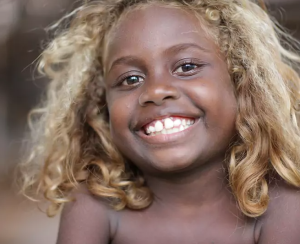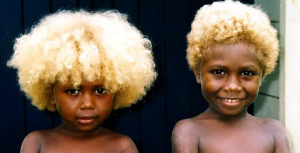Meet the world’s only natural black blondes, the Melanesians. Blond hair was once thought to be exclusively associated with Caucasians, although the Melanesians of the Solomon Islands are among the rare non-European populations having blonde hair. Black islanders from the South Pacific known as Melanesians moved thousands of years ago, before black people came to the Americas as slaves.

Meet the world’s only natural black blondes, the Melanesians
Melanesia is a subregion of Oceania that stretches eastward to Fiji and from the western edge of the Pacific to the Arafura Sea. The majority of the islands that are directly north and northeast of Australia are included in this region; these include the nations of Solomon Island, Fiji, Vanuatu, Papua New Guinea, and New Caledonia. Jules Dumont d’Urville initially referred to this group of islands as Melanesia in 1832 in order to distinguish it from Polynesia and Micronesia in terms of geography and ethnicity.
Similar to the Asmat tribe, the native inhabitants of Melanesia engaged in cannibalism, headhunting, kidnapping, and enslavement until recently. However, as a result of interactions with Europeans, the majority of the population is now Christian. Still, over 90% reside in rural areas.
With their dark skin and blond hair, the Melanesian people of the Solomon Islands are the focus of attention. The Solomon Islands are an independent state within the British Commonwealth that are situated in the South Pacific, at the very center of Melanesia, northeast of Australia, between Papua and Vanuatu.
Five to ten percent of the native Melanesian inhabitants of the islands have bright blond hair, despite having the darkest skin tone outside of Africa. Numerous ideas have been put out to explain their blonde hair, including sun and salt bleaching, consuming a lot of fish, or genetic inheritance from mixed-breeding with the Europeans and Americans who first settled the islands.

Saliva and hair samples from 1209 Melanesian Solomon Island natives were subjected to a genetic examination by Sean Myles, a geneticist from Nova Scotia Agricultural College in Canada. He discovered that the blondes had two copies of a mutant gene, which is prevalent in 26 percent of the island’s population, after comparing 43 blond Islanders and 42 brown Islanders. The TYRP1 gene, which is unique to the Melanesian population and absent in Caucasians, is partially responsible for the blond hair and melanin of these people.
It is a recessive gene that is more prevalent in youngsters than in adults, and as a person ages, their hair usually turns darker. This supports the notion that all races descended from the black African race and that black Africans were the first Homo sapiens.
